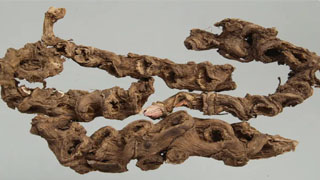
【 Source 】 Zhujie ginseng is the dried rhizome of the Araliaceae plant Zhujie ginseng.
【 Original Plant 】 Panax japonicus C A. Mey. Alias: Panax japonicus, Panax notoginseng, Arhat notoginseng.
Perennial herb, 50-100cm tall. The rhizome lies horizontally in the shape of bamboo whip, fleshy, with concave stem scars between nodules. The lower part of the short growing stem produces fleshy, fine radish like roots, white in color. The stem is upright, cylindrical, striped, smooth and hairless. Palm shaped compound leaves with 3-5 whorls at the stem tip; The petiole is 8-11cm long, striped, hairless, slightly flattened at the base: the leaflets are usually 5, smaller on both sides, membranous, inverted elliptical to long elliptical, 5-18cm long, 2-6.5cm wide, the tip gradually pointed to long gradually pointed, rarely tail shaped gradually pointed, the base is wide to nearly circular, slightly skewed on both sides, with fine or heavy serrations on the edges, and sparsely hairy along the veins on both sides. Umbelliferae inflorescence grows on the stem end with 50-80 flowers or more; The total stem length is 12-21cm, with stripes, hairless or slightly pubescent; Small flowers, light green; The stem of the small flower is 7-12mm long and slightly covered in short hairs; Calyx with 5 teeth, triangular ovate teeth, hairless; Petals 5, long ovate, arranged in a tiled pattern; Stamen 5, filaments shorter than petals; The ovary is lower, with 2-5 chambers, the style is 2-5, and it is connected below the middle. When fruiting, it bends outward. The fruit is nearly spherical, red when ripe, with a diameter of 5-7mm, containing 2-5 seeds, white, triangular long oval, 4.5mm long, and 3mm thick. The flowering period is from May to June, and the fruiting period is from July to September.
[Habitat distribution] Native to broad-leaved forests in valleys at elevations of 1800-3200m. Distributed in provinces and regions such as Yunnan, Sichuan, Guizhou, Guangxi, Zhejiang, and Anhui.
Harvesting and processing: In autumn, remove the main roots and outer skin, and dry.
【 Medicinal herb characteristics 】 Slightly cylindrical, slightly curved, some with fleshy lateral roots. Length 5-22cm, diameter 0.8-2.5cm. Yellow or yellow brown, rough, with dense longitudinal wrinkles and root marks. The nodes are obvious, with internode lengths ranging from 0.8 to 2cm, and each node has one concave stem mark. Hard in texture, with a yellow white to light yellow cross-section, and yellow dotted vascular bundles arranged in a ring. Odorless, with a bitter taste and a slightly sweet aftertaste.
[Processing and Decoction Pieces] Remove impurities. Crush it when needed,
[Taste Function] Sweet and slightly bitter in taste, warm in nature. It has the functions of nourishing and strengthening, dispersing blood stasis and relieving pain, stopping bleeding and eliminating phlegm.
【 Indications and Usage 】 Used for post illness weakness, coughing and hemoptysis, coughing with excessive phlegm, and injuries caused by falls. The dosage is 6-9g.


